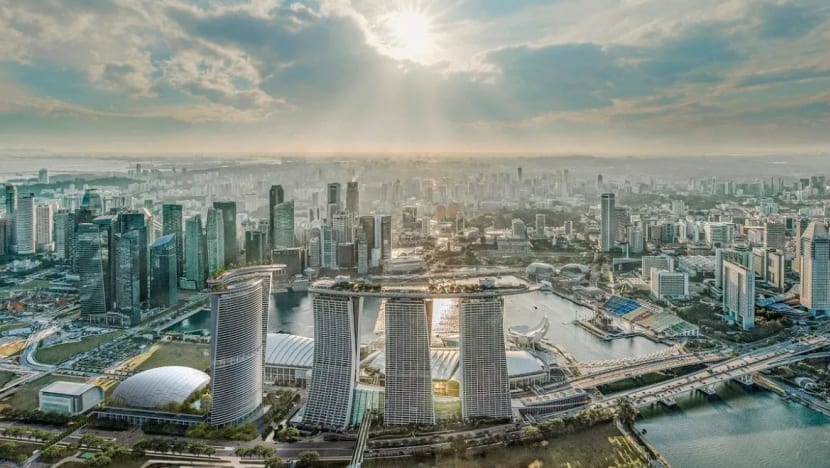Commentary: Japan's casino plan - and possibly Thailand's - threatens to dethrone Singapore's integrated resorts
Singapore’s integrated resorts will be 20 years old when Japan opens its first casino in 2030. Industry expert Daniel Cheng looks at the threat it poses to Marina Bay Sands and Resorts World Sentosa.

MGM Osaka will be built on the man-made island of Yumeshima. (Photo: Twitter/The Gov't of Japan)
SINGAPORE: Soon after the turn of the decade, Japan will start welcoming customers to its first casino in the western city of Osaka.
The ¥1.08 trillion (US$7.9 billion) project backed by a consortium that includes MGM Resorts will be the most expensive integrated resort ever built, a price tag that comes with the same lofty expectations to take the industry by storm.
Bets placed on the first spin of the roulette wheel at the man-made island of Yumeshima will herald a much-belated arrival to the party for Japan in the casino sector.
For it might very well have been the words uttered in 1999 by the late Tokyo governor, Shintaro Ishihara, advocating a casino in the Japanese capital that precipitated a change of heart by Singapore leaders to allow casino gambling.
Singapore's integrated resorts - Marina Bay Sands (MBS) and Resorts World Sentosa (RWS) - will be in the midst of putting up the bunting for their 20th anniversary celebrations when the new Japanese contender finally enters the ring.
MBS would have by then also added a fourth tower with 1,000 hotel rooms and a 15,000-seater entertainment arena, while RWS would have refurbished three of its hotels, expanded its aquarium and built a Minion Park and Super Nintendo World at Universal Studios Singapore.
Will their combined S$9 billion (US$6.75 billion) expansion be sufficient to buttress against an onslaught of Japanese integrated resorts? Or will MGM Osaka - to be built at the combined initial investments of the two Singapore integrated resorts - usurp their market leadership?

CARDS ON THE TABLE
Indeed, a multibillion-dollar expansion bill is more than a mere facelift, but the cost to be incurred is as much to increase capacity as for a makeover. With Japan ranked by far as the favourite haunt for outbound Chinese travellers who represent the largest demographic segment in the casino industry, incumbent Asian resorts look fated to surrender market share to Japan.
The official Osaka integrated resort area development plan projects an annual revenue of ¥520 billion. That is more than twice the turnover of RWS and 20 per cent above MBS’ in 2019 before COVID-19 struck. The heady numbers are betting that the “bakugai” phenomenon of “explosive” Chinese tourists shopping behaviour in Japan will be repeated on the casino floor.
The Osaka resort is also projected to attract 20 million visitors yearly, which is equivalent to anecdotal visitorship numbers in the first year of operations at MBS.
Barring more force majeure, the loss of market share of the incumbent Asian casinos to MGM Osaka will be mitigated to some extent by a continually growing Asian leisure market. As it is, the Singapore duopoly already dodged a bigger bullet because the Japanese government hadn’t particularly grasped the crux of its success despite having a front-row seat to the emergence of the new breed of casino integrated resorts in Asia.
That they failed to emulate the tiered casino tax regime in Singapore and the Philippines is an important lifeline for Japan’s competing jurisdictions and puts MGM Osaka at a disadvantage in the key high-roller gambler segment.
A maladroit process has also left two Japanese integrated resort licences unspoken for, resulting in a casino monopoly in Osaka that could well be content to milk the Japanese domestic market as its main target.
LET THE CHIPS FALL WHERE THEY MAY
Japan may not be the only worry for the Singapore integrated resort industry, with a threat looming closer to home.
A bipartisan government effort in Thailand has made great strides to legalise casino gambling, with a plan to house them in entertainment complexes in up to five locations across the country.
If the Thais keep up that momentum after the May national elections, there is every possibility that Thai casinos may give Singapore a run for its money before Japan.
Thailand is a worthy match for Japan in the tourism stakes, with a genre that makes for greater appeal in entertainment and casino gambling. Singapore has more to fear in Thailand than Japan, not least in its closer proximity, even with MBS and RWS refreshed.
Genting and Las Vegas Sands, the owners of RWS and MBS respectively, will also be concerned over the expiration of the extension of their exclusivity in 2030. All that coming to a head may warrant something more drastic if the Singapore gaming industry is to keep its position at the top. Various extant factors are possible portents of a needed reinvention.
Genting owner Lim Kok Thay, just shy of 80 years old in 2030, will surely have handed the reins over to the third generation in the family by then.
Having worked directly under the stripling Lim Keong Hui, I have no doubt he shares his father’s business acuity but with decidedly different strokes. The millennial Lim looks more inclined to discovering his own unicorn business than filling the shoes in the family’s comparatively antediluvian gambling business.
Australian James Packer had not shared the penchant for casinos as his late father Kerry did and stepped down from gaming empire Crown Resorts about 10 years after his father’s death.
Might a change in ownership be the tonic for Singapore’s integrated resorts to respond to the threat of new competition?
Regardless, the younger Lim at the helm will bring a fresh pair of eyes and chart a new path for the RWS, even if the business stays in the family.
As for MBS, there is no certainty the Singapore property will not go on the selling block if the price is right. In 2021, its parent Las Vegas Sands sold its Vegas casinos in a US$6.25 deal, two months after founder Sheldon Adelson died.
SWEETEN THE POT
It’s just as well that Singapore’s tourism strategy does not place all its eggs in the integrated resort basket.
MBS hasn’t put a foot wrong from day one and is finding its old swagger again now that the pandemic has passed, but the iconic Singapore landmark will be a grand old dame when MGM Osaka comes on stream.
MBS is but a cog in the Marina downtown masterplan to create a vibrant work, live, and play environment, while RWS is one element in the leisure playground ecosystem for Sentosa Island that represents a strand in the greater national tourism blueprint.
The integrated resorts, Gardens by the Bay, Singapore Grand Prix, the burgeoning cruise sector, and the partnership with Disney Cruise Line in 2025 are a sliver of the initiatives to continuously keep the tourism product fresh.
The tourism industry is but one facet of Singapore’s long-term economic strategy, underpinned by the development and growth of a modern metropolis infrastructure that contributes to its stature as a regional transportation and financial hub.
The sum of all these parts is concomitant with the efficacy of each sector, which has bequeathed the two integrated resorts their phenomenal success. It is in conformance with this macro integrated playbook that will help keep Singapore casino resorts one step ahead of the pack.
Daniel Cheng is a former senior industry executive and the author of Japan Casino Uprising, which recounts the legalisation of casinos in Japan.


















